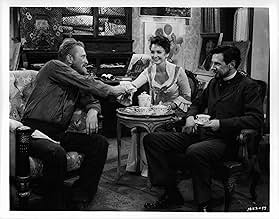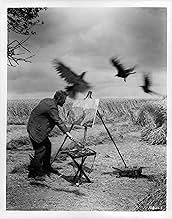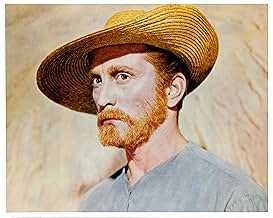AVALIAÇÃO DA IMDb
7,3/10
13 mil
SUA AVALIAÇÃO
A vida do brilhante, mas torturado artista Vincent van Gogh.A vida do brilhante, mas torturado artista Vincent van Gogh.A vida do brilhante, mas torturado artista Vincent van Gogh.
- Ganhou 1 Oscar
- 4 vitórias e 6 indicações no total
- Direção
- Roteiristas
- Elenco e equipe completos
- Produção, bilheteria e muito mais no IMDbPro
Enredo
Você sabia?
- CuriosidadesIn his memoir "The Ragman's Son" Kirk Douglas recounted that John Wayne attended a screening of the film, and was horrified. "Christ, Kirk! How can you play a part like that? There's so few of us left. We got to play strong, tough characters. Not those weak queers," Wayne said. Douglas tried to explain, "It's all make-believe, John. It isn't real. You're not really John Wayne, you know." Wayne (born Marion Morrison) looked at him oddly, as if Douglas had betrayed him.
- Erros de gravaçãoAt Arles, when Paul Gauguin is explaining his philosophy, Vincent mistakes him for Theo saying "but Theo, err Paul..." However, this is in the script. The whole point of the line is that Van Gogh views his conversation with Gauguin as nothing more than an extension of talks he's had with Theo since childhood.
- Citações
Paul Gauguin: I'm talking about women, man. Women. I like 'em fat and vicious and not too smart. Nothing spiritual either. To have to say 'I love you' would break my teeth. I don't want to be loved.
Vincent Van Gogh: You really mean that, Paul.
- ConexõesFeatured in Van Gogh: Darkness Into Light (1956)
- Trilhas sonorasLa Marseillaise
(1792) (uncredited)
Written by Claude Joseph Rouget de Lisle
Played by a band in France, near the end
Avaliação em destaque
Irving Stone wrote his book 'Lust for Life' in 1934 and MGM obtained the film rights to it in 1946, long before there was any intention to create this film. Biographical films about the lives of artists were not regarded as likely to be financially viable, and at the time Van Gogh, who had only sold one painting in his lifetime, was not really well known to the public or regarded as the most promising subject for such a film. This changed following a very successful exhibition of his works in 1955 and MGM decided to commission Minnelli to direct the film for them, but they had little time left to create it as their film rights to the book expired at the end of 1955. This greatly complicated the production. For example, rights to create still reproductions of almost 200 of Van Gogh's works for this film had to be negotiated with all the museums, galleries and private collectors world-wide who owned them, the pictures then had to be copied by special still cameras requiring only low illumination levels, and printed as large transparencies that could be back-lit for filming in any scenes where they were visible. Minnelli was a good choice as Director - previously a stage designer he was known for artistic sensibilities and an eye for colour. In his memoirs Minnelli reports two major battles with the studio moguls, one he won - the other he lost. Minnelli knew the Metrocolor process used at MGM generated saturated colours which would be too garish for this film. He had recently finished filming Brigadoon using Anscocolor stock and insisted this was what was needed, but Anscocolor cine stock had just been discontinued. MGM eventually agreed to buy up the last 300,000 feet of unused Anscocolor stock available, and to set up a laboratory in which it could be processed. Minnelli also bitterly opposed working in CinemaScope format, claiming the large aspect ratio was incompatible with most paintings, and would also spoil the intimacy of many of the scenes to be filmed; but he was over-ruled on this.
Half a century later we are in a position to appreciate how right he was over both these issues. Like most viewers my first reactions to a film I am watching usually relate to the quality of the film-script, the direction and the acting. If these are acceptable I know I am likely to feel that I have seen a very good film. But film stock remains very important - as a still photographer myself I am well aware of the need to evaluate whether a particular shot should be made on, for example, Fuji's Sensia, Astia or Velvia emulsions - the wrong choice usually destroys the effect the photographer is striving for. It is the same with movies - I can recall just four films ('The Riddle of the Sands',' Laura, les Ombres de l'Ete', 'Black Narcissus' and 'Lust for Life') where one of my first reactions has been admiration for the atmospheric qualities and colour rendering of the photography. There may have been others but such films are certainly not very numerous. Although the opening credits of L4L still attribute the colour to Metrocolor, this film could not have succeeded as it did if MGM had been unable to obtain the Ansco stock that was actually used. As for aspect ratio, we have only to compare the VHS version with the new widescreen DVD to confirm that Minnelli's vision was correct (and this is of course after he did everything possible to utilise sequences which take maximum advantage of the widescreen presentation that he was forced to adopt.)
The film-script has been criticised for inaccuracies in Van Gogh's life as shown (unfairly as it is based on Irving Stone's book, which is normally classed as a novel rather than a biography. MGM might have done better to write an independent film-script and present their film as a biography- not as a film of a novel. What probably prevented this was recognition that they would then be responsible for any errors.) As written it is a very powerful depiction of the gradually increasing intensity of Van Gogh's commitment to his art, which increasingly became the only significant driving force in everything he did. The two hour overall running time is just about right - the emotional impact of watching the gradual disintegration of Van Gogh's personality might have become quite distressing for some viewers if the film has been a great deal longer.
The acting is exceptional. Kirk Douglas, a remarkable look-alike to extant pictures of Van Gogh, put everything into his effort to create a believable picture of a man with an increasingly fanatical drive which eventually overwhelmed him. It earned him an Oscar nomination, but not an award. This, I feel, was not his fault - Van Gogh was too insecure to interact normally with others and this would have showed in his whole bearing, something an individual as secure and stable as Kirk could not easily emulate. An actor is by nature an extreme extrovert and trying to take the part of an introvert is very difficult - when the introvert is both fanatical and unbalanced it probably becomes impossible. This makes it hard to become involved with Kirk's portrayal of the role in the same way that one would have done with Van Gogh himself. Anthony Quinn's Best Supporting Actor Oscar award for his role as Paul Gauguin was well deserved. There were also memorable performances by James Donald as Theo and Pamela Brown as Christine. Theo's anguish in the deathbed sequence came over very effectively. The direction and camera work, although not faultless, were both of an extremely high standard. All in all, anyone interested either in modern painting or in the lives of modern painters will find this a most rewarding film to watch.
Half a century later we are in a position to appreciate how right he was over both these issues. Like most viewers my first reactions to a film I am watching usually relate to the quality of the film-script, the direction and the acting. If these are acceptable I know I am likely to feel that I have seen a very good film. But film stock remains very important - as a still photographer myself I am well aware of the need to evaluate whether a particular shot should be made on, for example, Fuji's Sensia, Astia or Velvia emulsions - the wrong choice usually destroys the effect the photographer is striving for. It is the same with movies - I can recall just four films ('The Riddle of the Sands',' Laura, les Ombres de l'Ete', 'Black Narcissus' and 'Lust for Life') where one of my first reactions has been admiration for the atmospheric qualities and colour rendering of the photography. There may have been others but such films are certainly not very numerous. Although the opening credits of L4L still attribute the colour to Metrocolor, this film could not have succeeded as it did if MGM had been unable to obtain the Ansco stock that was actually used. As for aspect ratio, we have only to compare the VHS version with the new widescreen DVD to confirm that Minnelli's vision was correct (and this is of course after he did everything possible to utilise sequences which take maximum advantage of the widescreen presentation that he was forced to adopt.)
The film-script has been criticised for inaccuracies in Van Gogh's life as shown (unfairly as it is based on Irving Stone's book, which is normally classed as a novel rather than a biography. MGM might have done better to write an independent film-script and present their film as a biography- not as a film of a novel. What probably prevented this was recognition that they would then be responsible for any errors.) As written it is a very powerful depiction of the gradually increasing intensity of Van Gogh's commitment to his art, which increasingly became the only significant driving force in everything he did. The two hour overall running time is just about right - the emotional impact of watching the gradual disintegration of Van Gogh's personality might have become quite distressing for some viewers if the film has been a great deal longer.
The acting is exceptional. Kirk Douglas, a remarkable look-alike to extant pictures of Van Gogh, put everything into his effort to create a believable picture of a man with an increasingly fanatical drive which eventually overwhelmed him. It earned him an Oscar nomination, but not an award. This, I feel, was not his fault - Van Gogh was too insecure to interact normally with others and this would have showed in his whole bearing, something an individual as secure and stable as Kirk could not easily emulate. An actor is by nature an extreme extrovert and trying to take the part of an introvert is very difficult - when the introvert is both fanatical and unbalanced it probably becomes impossible. This makes it hard to become involved with Kirk's portrayal of the role in the same way that one would have done with Van Gogh himself. Anthony Quinn's Best Supporting Actor Oscar award for his role as Paul Gauguin was well deserved. There were also memorable performances by James Donald as Theo and Pamela Brown as Christine. Theo's anguish in the deathbed sequence came over very effectively. The direction and camera work, although not faultless, were both of an extremely high standard. All in all, anyone interested either in modern painting or in the lives of modern painters will find this a most rewarding film to watch.
- bbhlthph
- 9 de jun. de 2006
- Link permanente
Principais escolhas
Faça login para avaliar e ver a lista de recomendações personalizadas
Detalhes
Bilheteria
- Orçamento
- US$ 3.227.000 (estimativa)
- Tempo de duração2 horas 2 minutos
- Cor
- Proporção
- 2.55 : 1
Contribua para esta página
Sugerir uma alteração ou adicionar conteúdo ausente


![Assistir a Trailer [OV]](https://m.media-amazon.com/images/M/MV5BNjMwYjdhMDItMDA1NC00YjJlLWFhZjctYWY5YjBlNDdiODFiXkEyXkFqcGdeQXRyYW5zY29kZS13b3JrZmxvdw@@._V1_QL75_UX500_CR0)




































